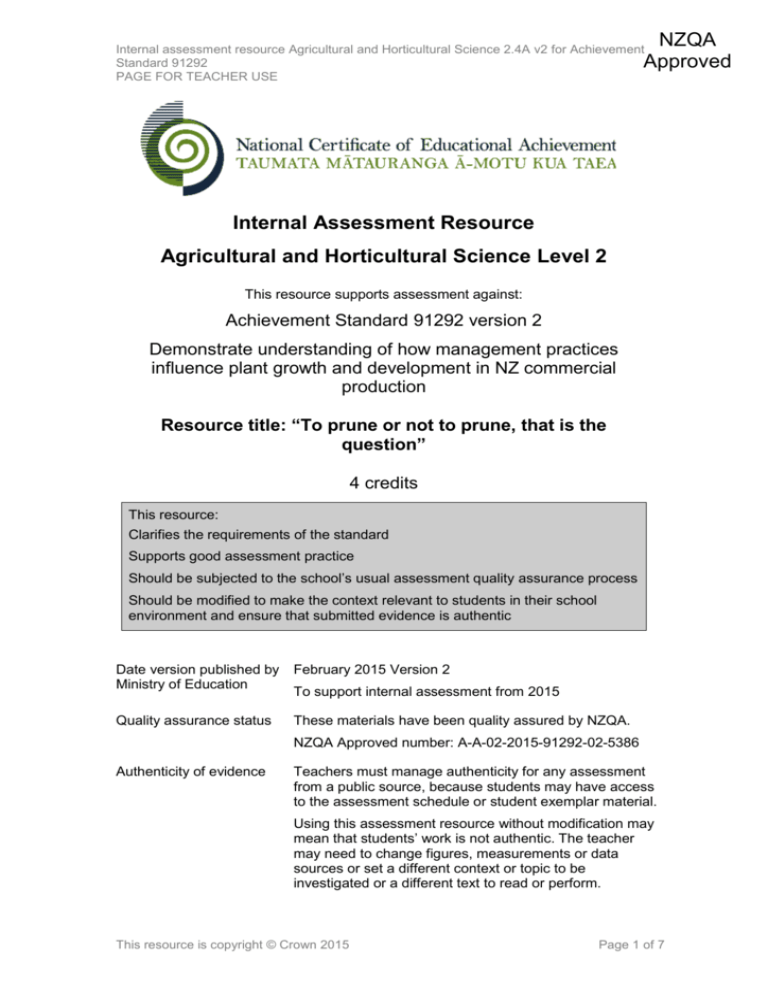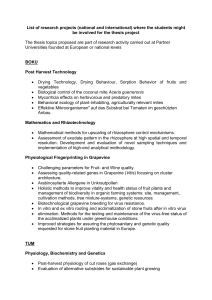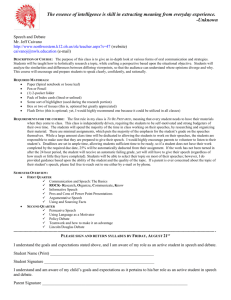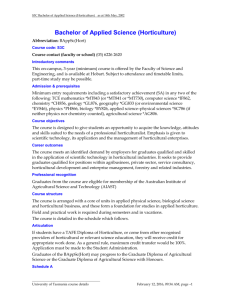aghort2_4A_v2_feb15
advertisement

NZQA Approved Internal assessment resource Agricultural and Horticultural Science 2.4A v2 for Achievement Standard 91292 PAGE FOR TEACHER USE Internal Assessment Resource Agricultural and Horticultural Science Level 2 This resource supports assessment against: Achievement Standard 91292 version 2 Demonstrate understanding of how management practices influence plant growth and development in NZ commercial production Resource title: “To prune or not to prune, that is the question” 4 credits This resource: Clarifies the requirements of the standard Supports good assessment practice Should be subjected to the school’s usual assessment quality assurance process Should be modified to make the context relevant to students in their school environment and ensure that submitted evidence is authentic Date version published by Ministry of Education February 2015 Version 2 Quality assurance status These materials have been quality assured by NZQA. To support internal assessment from 2015 NZQA Approved number: A-A-02-2015-91292-02-5386 Authenticity of evidence Teachers must manage authenticity for any assessment from a public source, because students may have access to the assessment schedule or student exemplar material. Using this assessment resource without modification may mean that students’ work is not authentic. The teacher may need to change figures, measurements or data sources or set a different context or topic to be investigated or a different text to read or perform. This resource is copyright © Crown 2015 Page 1 of 7 Internal assessment resource Agricultural and Horticultural Science 2.4A v2 for Achievement Standard 91292 PAGE FOR TEACHER USE Internal Assessment Resource Achievement Standard Agricultural and Horticultural Science 91292: Demonstrate understanding of how management practices influence plant growth and development in NZ commercial production Resource reference: Agricultural and Horticultural Science 2.4A v2 Resource title: “To prune or not to prune, that is the question” Credits: 4 Teacher guidelines The following guidelines are designed to ensure that teachers can carry out valid and consistent assessment using this internal assessment resource. Teachers need to be very familiar with the outcome being assessed by the Achievement Standard Agricultural and Horticultural Science 91292. The achievement criteria and the explanatory notes contain information, definitions, and requirements that are crucial when interpreting the standard and assessing students against it. Context/setting This assessment activity requires students to research, prepare, and write three speeches for a “paper debate” that compares two management practices that influence plant growth and development in commercial production in New Zealand. Students will not be required to participate in a debate but you may wish to give them the opportunity to present or debate their speeches. Another option is to divide the class into debating teams where they use the written speeches as a starting point to debate the topic/s. The class can vote on the result. Adapt this resource to meet the needs of your students. Provide students with a topic for debate, and let them know whether they are to support or negate this topic. The topics could relate to your local agriculture and horticulture produce, for example, Hawke’s Bay apples, Marlborough grapes, or Northland mandarins. Possible topics include: “Thinning of grapes is better than pruning vines, to achieve high quality fruit for the wine market” “Application of fertiliser for potato crops is more important than irrigation in producing a high yield” “Maintaining good hygiene in an apple orchard is better than good pest and disease control to ensure that neither the fruit nor the tree are damaged resulting in reduced production” “Regular pruning of capsicum plants grown in a greenhouse is better than This resource is copyright © Crown 2015 Page 2 of 7 Internal assessment resource Agricultural and Horticultural Science 2.4A v2 for Achievement Standard 91292 PAGE FOR TEACHER USE reducing the plant density, in maintaining a high yield of high quality fruit ready for the export market.” Take care when writing debate topics to ensure that both management practices have merit and are debatable. Students will write speeches for the hypothetical first, second, and third speaker. 1. The first speaker describes the management practices and how each practice affects plant growth and development in commercial production. 2. The second speaker explains how each practice influences plant growth and development in commercial production. 3. The third speaker argues either for or against the topic by evaluating the benefits of each management practice and justifying their viewpoint. Students will be assessed on their written speeches, primarily their ability to evaluate management practices that influence plant growth and development in commercial plant production. The positive outcome of this assessment activity would be that the topic/s can be revisited and discussed. Conditions It is suggested that one week of in-class time and homework time should be allocated for students to research, prepare and to write the debate speeches. Resource requirements Students will require internet and library access for research. Access to local producers may also be useful. Additional information Prior to this activity, expose students to examples of debates highlighting correct etiquette for the speakers and the audience. You could demonstrate this by organising a debate between local growers. This resource is copyright © Crown 2015 Page 3 of 7 Internal assessment resource Agricultural and Horticultural Science 2.4A v2 for Achievement Standard 91292 PAGE FOR STUDENT USE Internal Assessment Resource Achievement Standard Agricultural and Horticultural Science 91292: Demonstrate understanding of how management practices influence plant growth and development in NZ commercial production Resource reference: Agricultural and Horticultural Science 2.4A v2 Resource title: “To prune or not to prune, that is the question” Credits: 4 Achievement Demonstrate understanding of how management practices influence plant growth and development in commercial production in New Zealand. Achievement with Merit Demonstrate in-depth understanding of how management practices influence plant growth and development in commercial production in New Zealand. Achievement with Excellence Demonstrate comprehensive understanding of how management practices influence plant growth and development in commercial production in New Zealand. Student instructions Introduction In this assessment activity you will research, prepare, and write three speeches for a “paper debate” that compares two management practices that influence plant growth and development in commercial production in New Zealand. Management practices include the actions taken by growers which impact on the timing of production, the quantity and quality of the end products and economics of production. Your teacher will provide you with a topic for the debate, and whether you are affirmative (in favour) or negative (against). You will not be required to participate in an actual debate. Teacher note: You may wish to give students the opportunity to present or debate their speeches. Adapt this resource to meet the needs of your students. You will be assessed on your written speeches, primarily your ability to evaluate management practices that influence plant growth and development in commercial plant production. This may involve justifying, comparing/contrasting, and analysing. This is an individual activity. You have one week of in-class and homework time to research, prepare, and write the debate speeches. This resource is copyright © Crown 2015 Page 4 of 7 Internal assessment resource Agricultural and Horticultural Science 2.4A v2 for Achievement Standard 91292 PAGE FOR STUDENT USE Task Your topic for the debate is: “Regular pruning of capsicum plants grown in a greenhouse is better than reducing the plant density, in maintaining a high yield of high quality fruit suitable for the export market.” Teacher note: Adapt the Student instructions sheet to suit the topic chosen. You will write speeches for the affirmative team. Teacher note: Adapt the Student instructions sheet to suit the argument – affirmative or negative. 1. The first speaker’s speech will need to describe both management practices and how each practice affects plant growth and development in commercial production. Include diagrams and photos if relevant. 2. The second speaker’s speech will need to explain how each practice influences plant growth and development in commercial production. 3. The third speaker’s speech argues either for [or against] the topic by evaluating the benefits of each management practice and justifying their viewpoint. They could compare/contrast or analyse the affects of the management practices on the commercial production of the crop. When read out loud, each speech could be 4-5 minutes long. Resources Use your course notes, the internet, library, and field trip notes as background material for this activity. It may also be useful to contact local producers. This resource is copyright © Crown 2015 Page 5 of 7 Internal assessment resource Agricultural and Horticultural Science 2.4A v2 for Achievement Standard 91292 PAGE FOR TEACHER USE Assessment schedule: Agricultural and Horticultural Science 91292 “To prune or not to prune, that is the question” Evidence/Judgements for Achievement Evidence/Judgements for Achievement with Merit Evidence/Judgements for Achievement with Excellence The student demonstrates understanding of two management practices that influence plant growth and development in commercial production in New Zealand. They describe how each of the management practices influences plant growth and development in commercial plant production. The student demonstrates in-depth understanding of two management practices that influence plant growth and development in commercial production in New Zealand. They explain how each management practice influences plant growth and development in commercial plant production. For example: Capsicum plants are pruned to remove the apical bud and flowers for the first four nodes. This will result in a higher fruit yield from branches which develop later. The plants are grown in sterile media in bags which makes controlling the planting density relatively easy. Plants are usually planted at a minimum 0.5m apart depending on the variety of the capsicum. This allows for sufficient air to circulate which will reduce opportunity for fungal growth whilst maintaining sufficient yield to be produced. For example: Pruning plants at the apical bud removes apical dominance caused by the production of auxin at the tip. This encourages the plants to branch and produce a strong framework on which to bear fruit. The removal of flowers stops fruit forming too early before the plants have less chance to establish the framework. Continued pruning stops leaves shading each other increasing photosynthetic rate. The plants are grown in sterile media in bags which makes controlling the planting density relatively easy. Plants are usually planted at a minimum 0.5m apart depending on the variety of the capsicum. Density control has the same effect on plant growth as training and pruning. Decreased density reduces the need for vigorous pruning and increases light penetration and air movement between plants. The student demonstrates comprehensive understanding of two management practices that influence plant growth and development in commercial production in New Zealand. They evaluate how the management practices influence plant growth and development in commercial plant production. To do this, they may justify, compare/contrast or analyse the affects of the practices on production. For example: Pruning maintains strong plants which are gaining enough light to photosynthesise to form strong supportive plants and support a high yield per plant (15kg approx depending on the variety). The fruit have enough light to grow large and have a good blocky shape through careful pruning and control of flower formation. The fruit develop a high brix level of sugar. The plants are grown in sterile media in bags which makes controlling the planting density relatively easy. Plants are usually planted at a minimum 0.5m apart depending on the variety of the capsicum. Density control has the same effect on plant growth as training and pruning. Decreased density reduces the need for vigorous pruning and increases light penetration and air movement between plants. Air circulation around the plants reduces the incidence of stem rot which is prevalent in This resource is copyright © Crown 2015 Page 6 of 7 Internal assessment resource Agricultural and Horticultural Science 2.4A v2 for Achievement Standard 91292 PAGE FOR TEACHER USE capsicums and kills whole plants. Increased air circulation also reduces fruit rot and skin blemishes which make the fruit unsuitable for export. The problem with decreased density is that there are fewer plants per hectare. This means that the overall yield can be greatly reduced compared with pruning which allows for a high yield of high quality fruit. Final grades will be decided using professional judgement based on a holistic examination of the evidence provided against the criteria in the Achievement Standard. This resource is copyright © Crown 2015 Page 7 of 7




